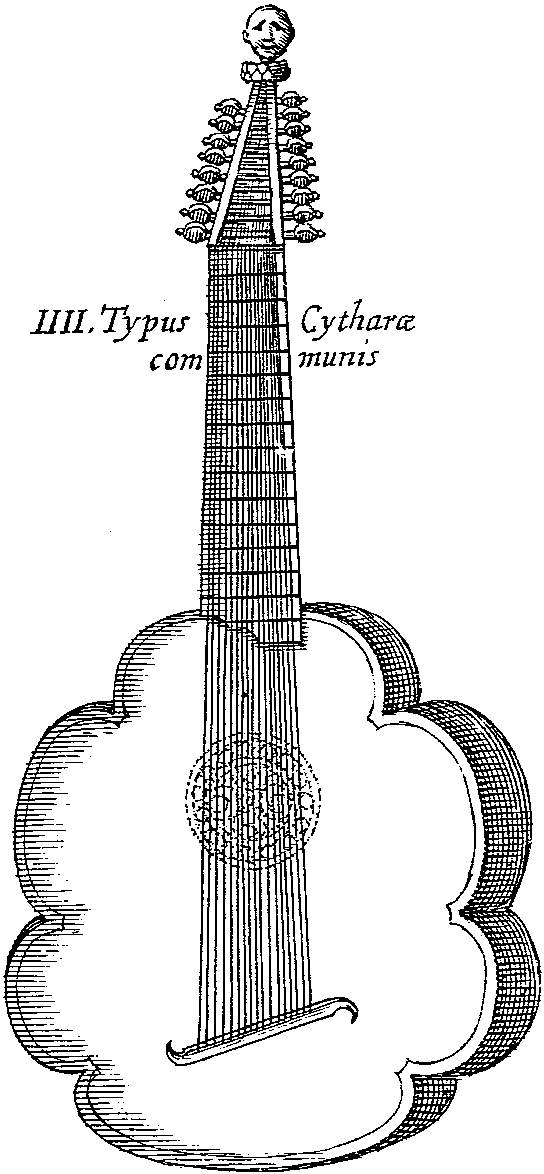
Orpharion
Encyclopedia

Renaissance
The Renaissance was a cultural movement that spanned roughly the 14th to the 17th century, beginning in Italy in the Late Middle Ages and later spreading to the rest of Europe. The term is also used more loosely to refer to the historical era, but since the changes of the Renaissance were not...
. It is part of the cittern
Cittern
The cittern or cither is a stringed instrument dating from the Renaissance. Modern scholars debate its exact history, but it is generally accepted that it is descended from the Medieval Citole, or Cytole. It looks much like the modern-day flat-back mandolin and the modern Irish bouzouki and cittern...
family. Its construction is similar to the larger bandora. The metal strings are tuned like a lute and are plucked with the fingers. Therefore, the orpharion can be used instead of a lute
Lute
Lute can refer generally to any plucked string instrument with a neck and a deep round back, or more specifically to an instrument from the family of European lutes....
. The nut and bridge
Bridge (instrument)
A bridge is a device for supporting the strings on a stringed instrument and transmitting the vibration of those strings to some other structural component of the instrument in order to transfer the sound to the surrounding air.- Explanation :...
of an orpharion are typically sloped, so that the string length increases from treble
Clef
A clef is a musical symbol used to indicate the pitch of written notes. Placed on one of the lines at the beginning of the staff, it indicates the name and pitch of the notes on that line. This line serves as a reference point by which the names of the notes on any other line or space of the staff...
to bass. Due to the extremely low-tension metal strings, which would easily distort the notes when pushed down, the frets were almost flush with the fingerboard, which was gently scalloped. As with all metal-strung instruments of the era, a very light touch with the plucking hand was required, quite different from the sharper attack used on the lute.
The orpharion was invented in England
England
England is a country that is part of the United Kingdom. It shares land borders with Scotland to the north and Wales to the west; the Irish Sea is to the north west, the Celtic Sea to the south west, with the North Sea to the east and the English Channel to the south separating it from continental...
in the second half of the 16th century. In sources of English music it is often mentioned as an alternative to the lute. According to Stow's "Annals" (1631), John Rose of Bridewell invented the instrument in 1581. There is a Rose Orpharion in Helmingham Hall
Helmingham Hall
Helmingham Hall is a moated manor house in Helmingham, Suffolk, England. It was begun by John Tollemache in 1480 and has been owned by the Tollemache family ever since. The house is built around a courtyard in typical late medieval/Tudor style....
which was allegedly given as a gift to Queen Elizabeth, and may well be that first example. It has 6 courses and the bridge and nut are parallel. The only other surviving Orpharion, now in the Claudius Collection in Copenhagen, has 9 courses with sloping frets, and dates to 1617.
The name of Orpharion comes from "Orpheus
Orpheus
Orpheus was a legendary musician, poet, and prophet in ancient Greek religion and myth. The major stories about him are centered on his ability to charm all living things and even stones with his music; his attempt to retrieve his wife from the underworld; and his death at the hands of those who...
" and "Arion
Arion
Arion was a kitharode in ancient Greece, a Dionysiac poet credited with inventing the dithyramb: "As a literary composition for chorus dithyramb was the creation of Arion of Corinth," The islanders of Lesbos claimed him as their native son, but Arion found a patron in Periander, tyrant of Corinth...
".

